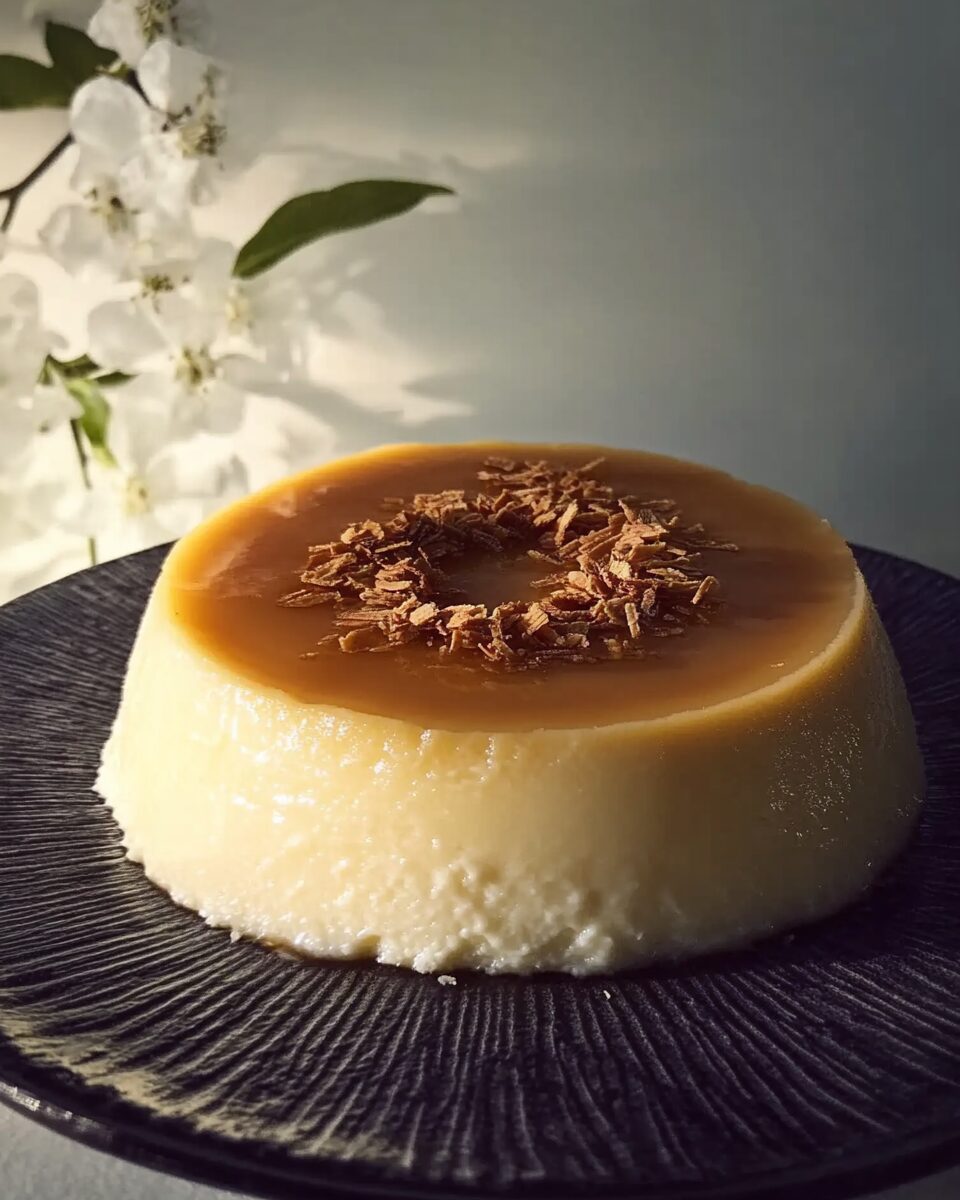Coconut Flan is a luxurious, silky-smooth dessert that brings together the creamy texture of traditional flan with the tropical sweetness of coconut. Popular in Latin American and Caribbean cuisines, this custard-based treat features a delicate balance of eggs, sweetened condensed milk, coconut milk, and shredded coconut, all topped with a glossy caramel layer. It’s perfect for dinner parties, celebrations, or whenever you’re craving something sweet and exotic.
Full Recipe:
Ingredients
- 1 cup white sugar
- 3 eggs
- 1 (14 ounce) can sweetened condensed milk
- 1 (13.5 ounce) can coconut milk
- ½ cup flaked coconut
- 1 teaspoon vanilla extract
Directions
- Preheat oven to 350°F (175°C).
- In a medium saucepan over medium-low heat, melt the sugar until liquefied and golden in color. Carefully pour hot syrup into a round 9-inch baking dish, turning the dish to evenly coat the bottom. Set aside.
- In a blender or large bowl, mix eggs, sweetened condensed milk, coconut milk, flaked coconut, and vanilla extract until smooth.
- Pour the mixture into the prepared caramel-lined dish.
- Place the dish in a larger baking pan filled with about 1 inch of hot water (water bath).
- Bake for 50 to 60 minutes, or until a knife inserted near the center comes out clean.
- Let cool, then refrigerate for at least 4 hours before inverting onto a plate to serve.
Nutrients
Estimated per serving (based on 8 servings)
- Calories: 340
- Total Fat: 16g
- Saturated Fat: 12g
- Cholesterol: 85mg
- Sodium: 95mg
- Total Carbohydrates: 45g
- Dietary Fiber: 1g
- Sugars: 42g
- Protein: 6g
- Vitamin A: 6% DV
- Vitamin C: 2% DV
- Calcium: 15% DV
- Iron: 8% DV
Cultural Background
Flan, also known as caramel custard, has roots in Roman times, when early versions were made with honey and egg. The dish evolved over centuries, making its way through Europe, particularly Spain, and eventually traveled to Latin America and the Caribbean during the colonial period. There, it became an essential part of the culinary fabric, with each region adding its own signature twist.
Coconut flan is one such variation that likely emerged in the Caribbean, where coconuts are abundant and often used in both savory and sweet dishes. In places like Puerto Rico, Cuba, and the Dominican Republic, coconut is a staple ingredient, and its pairing with flan created a perfect fusion of creamy and tropical.
The combination of eggs, sweetened condensed milk, and coconut milk creates a custard that is both deeply satisfying and evocative of warm, coastal climates. Coconut flan continues to be a mainstay at holiday feasts, birthdays, and religious celebrations, often served chilled and flipped onto a decorative platter with its golden caramel sauce glistening on top.
Flavor Profile
The beauty of coconut flan lies in its harmonious flavor balance. The foundation is rich and sweet, with sweetened condensed milk delivering a deep, almost toffee-like flavor. Coconut milk introduces a creamy and slightly nutty essence that rounds out the sweetness and adds complexity.
The use of real shredded or flaked coconut enhances the tropical undertone and adds subtle texture, contrasting beautifully with the smooth custard. Meanwhile, vanilla extract offers floral and warm notes that elevate the dessert’s overall profile.
The caramel topping—made by melting sugar until golden—creates a slightly bitter, glossy layer that cuts through the richness and adds a hint of sophistication. Every bite is a journey of creamy, nutty, and sweet flavors, making it a truly memorable dessert.
Texture and Mouthfeel
Texture plays a major role in the allure of coconut flan. A perfectly made flan is ultra-smooth, almost silky, and delicately wobbly. The coconut flan adds a slight deviation from traditional flan by incorporating shredded coconut, which introduces a faint chewiness throughout the custard.
This juxtaposition between creamy and slightly fibrous textures creates an intriguing mouthfeel that many find irresistible. When flipped onto a serving plate, the caramel sauce coats the flan and drips over the sides, adding both shine and a luxurious finish.
Served chilled, the flan becomes even firmer and more satisfying, delivering a cooling sensation that is especially pleasant during warm weather. It’s a dessert that looks and feels elegant, yet feels familiar and comforting to many.
Global Reach and Popularity
Though it originated from European and colonial culinary traditions, flan in its many forms has gained international popularity. Coconut flan, in particular, enjoys a wide presence in countries with tropical climates and an affinity for coconut.
In the Philippines, a similar dessert called “leche flan” may also incorporate coconut milk. In Brazil, variations of flan exist that use both sweetened condensed milk and coconut cream. In Mexico and Central America, coconut flan is served during holidays and religious events. Across the Caribbean islands, you’ll find unique spins based on local ingredients and cultural tastes.
The dessert has also gained traction in the U.S., particularly in multicultural cities where Latin American and Caribbean populations have introduced their cuisines to a broader audience. Coconut flan is now a featured item in many Latin bakeries and restaurants and is even being modernized in high-end culinary establishments.
Why Coconut Flan Is a Crowd-Pleaser
There’s something universally appealing about coconut flan. First, it’s incredibly approachable—the ingredients are pantry staples, the preparation is straightforward, and the final product is stunning. Second, the flavor is balanced enough to please a wide range of palates. Even those who are hesitant about coconut often find themselves surprised by how much they enjoy it in this context.
It also adapts well to a variety of occasions. Serve it in individual ramekins for an elegant dinner party, or make a large batch in a mold for a festive family celebration. Its make-ahead nature means it’s ideal for entertaining, allowing hosts to prepare it a day in advance and focus on other dishes.
Its versatility, simplicity, and indulgent flavor profile make it an unforgettable addition to any meal.
Serving Suggestions
Coconut flan is best served chilled and inverted onto a plate so that the caramel can gracefully cascade over the sides. For added flair, you can sprinkle toasted coconut flakes, fresh fruit, or a light whipped cream garnish on top.
Some creative plating ideas include:
- Serving with a tropical fruit salad on the side
- Drizzling with a hint of dark rum or coconut liqueur
- Garnishing with edible flowers or mint leaves for a gourmet touch
Pair it with a light espresso or strong black tea to balance its sweetness, or offer a fruity cocktail if serving at a tropical-themed party.
Health Considerations and Nutritional Insights
While coconut flan is undoubtedly an indulgent dessert, it does offer some nutritional value, especially from the coconut. Coconut milk contains healthy fats known as medium-chain triglycerides (MCTs), which are believed to support metabolism and brain function. Coconut also provides small amounts of minerals such as manganese and copper.
Eggs contribute protein, vitamin D, and B12, while condensed milk offers calcium. However, it is important to note that the dish is high in sugar and saturated fat, making moderation key.
Those seeking lighter versions can experiment with substitutions like:
- Using low-fat coconut milk or light evaporated milk
- Replacing sugar with natural sweeteners like maple syrup or stevia (though this may alter the caramelization)
- Using egg whites instead of whole eggs to reduce cholesterol content
These modifications can slightly reduce the richness while preserving the custard’s integrity.
Modern Twists and Adaptations
Contemporary chefs and home cooks alike are reinventing coconut flan to match evolving tastes and dietary needs. Vegan versions can be made using plant-based milk and egg substitutes like silken tofu or agar-agar. Others experiment with infusions such as lemongrass, lime zest, or cardamom to put a new spin on the traditional recipe.
For presentation, mini flans are becoming more popular—either in jars or elegant molds for individual servings. Flan parfaits, where layers of flan are alternated with coconut whipped cream and fruit, offer a playful take on the classic.
Creative crusts made from crushed coconut cookies or graham crackers add a textural contrast, giving the dessert more bite. These modern interpretations help keep coconut flan relevant while paying homage to its roots.
Occasions to Enjoy Coconut Flan
This dessert shines during:
- Holiday Dinners like Christmas, Easter, or Thanksgiving
- Cultural Festivals that celebrate Latin or Caribbean heritage
- Family Gatherings where it serves as a centerpiece dessert
- Dinner Parties thanks to its make-ahead convenience and presentation wow-factor
- Romantic Dinners for its soft, luxurious feel
Its chilled nature makes it ideal for summer entertaining, while its comforting richness fits beautifully in winter spreads.
Conclusion
Coconut Flan is more than just a dessert—it’s a reflection of history, culture, and culinary artistry. From its ancient European roots to its beloved status across the Caribbean and Latin America, it tells the story of migration, adaptation, and flavor fusion. Its creamy texture, rich coconut flavor, and caramel finish make it a standout on any table. As food trends evolve and palates diversify, coconut flan remains timeless. It offers familiarity through its custard base and surprise through its tropical twist. Whether enjoyed in its traditional form or as a modern reinvention, this dessert invites everyone to indulge in something sweet, simple, and deeply satisfying.






